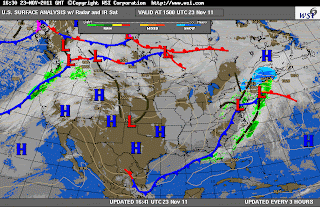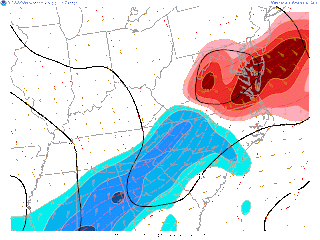This piece was written by Ms. Alex St. Pe, Professor Storm's grad student conducting research on severe storms in the UMBC GES program.
Star filled skies were visible for the first time in awhile Thursday evening (September 29, 2011) after persistent cloudy conditions and scattered showers exited the region behind a cold front. Unfortunately the clear skies were only temporary, as an upper-level disturbance vigorously dove south into the Ohio River Valley. Forecasters watched closely as the weather models predicted this wouldn’t be an ordinary low pressure system, and likely develop into a “cut-off low” feature. Confidence in a forecast involving a cut-off low is typically low amongst many meteorologists due to the system’s capricious movement and the unreliability of weather forecasting models.
Cut-off lows occur when a trough in the jet stream becomes so highly amplified that it literally pinches off, leaving the spinning low pressure system behind. A cut-off low has the characteristics of an upper-level cold-core center. Because the low is no longer embedded within the jet stream, the spinning whirlpool meanders slowly or becomes stationary. Associated showers typically form around the center of the low.
This past weekend, the Mid-Atlantic region experienced unseasonably cool temperatures, dreary overcast sky conditions and persistent showers in response to a cut-off low meandering towards the east coastline. In order to gain a better understanding of this past weekend’s relentless weather pattern, I will investigate the infamous cut-off low.
Thursday:
On Thursday evening (September 29, 2011) the 300mb pressure (~ 27,000 ft) map indicated strong north/northwesterly winds of approximately 100-120 knots ushering chilly Canadian air southward towards the Great Lakes Region. The pink contours on the map denote regions of “divergence aloft”. Areas of diverging winds at this level in the atmosphere create favorable conditions for the genesis of showers and storms at the surface.
This digging trough within the jet stream was forecast to become a closed upper-level low, or “cut-off low” during the day Friday, before dropping south into the Mid-Atlantic Friday night into Saturday. For this reason, forecasters across the Mid-Atlantic anticipated weekend weather conditions of noticeably cooler temperatures, and scattered showers.
Friday – Saturday:
Friday evening, a surface low-pressure system developed off the Delmarva Peninsula and created light showers ahead of the anticipated main shower event for the weekend. The surface low helped reinforce cold air arriving from the northwest.
On Saturday morning a cooler Canadian type air mass had successfully reached the Mid-Atlantic, with temperatures dropping the lowest for the season yet - the mid-40s. At 8am EDT atmospheric weather balloon data from Dulles International Airport (IAD) suggested a cold, deeply saturated vertical profile as the cut-off low approached the region. The tropopause, which is typically found at much higher altitudes (~12km), dropped down to an astoundingly low 7.5 km within the cold core of the cutoff vortex.
Notice the surface temperature within the orange circle. The surface temperature at 8am was 51 degrees Fahrenheit and actually dropped throughout the morning (the day’s high temperature, 61 F, occurred just after midnight!) before topping off in the lower 50s by 4pm.
By Saturday afternoon (October 01, 2011 3pm EDT) the 500mb (~15,000ft) pressure map indicated a closed circulation around the center of low pressure. The two height contours within the red oval provide evidence of an intense cut-off low over the Mid- Atlantic.
Once displaced from the jet stream’s steering winds, the movement of the cut-off low became very unpredictable. The system began to slowly meander eastward, producing a thick deck of stratus clouds, persistent precipitation, and chilly temperatures. At greater elevations near the Potomac Highlands, even cooler temperatures coupled with persistent precipitation generated a wintry mix along the western slopes of Allegheny Mountains.
Sunday-Monday:
As the cut-off low continued to spin across the northern Mid-Atlantic Sunday, light precipitation and dense cloud cover held temperatures steady in the mid-upper 40s for most of the day again. The weather system surprised some forecasters when it refused to exit off the coast Sunday, and extended its stay through the beginning of this week. According to the Storm Prediction Center’s 500mb pressure map, strong northwesterly winds (shaded blue) continued to filter cool air into the Mid-Atlantic area Monday morning. A strong mid-level temperature gradient is also noticeable from the closely spaced red-dashed temperature lines. Also worth noting is the difference in temperatures over Maryland/Virginia in comparison to Mississippi/Alabama. The cold-core of the cut-off low is clearly visible off the coast of Virginia, defined by the -24 C isotherm – nearly 14 C colder than air over Mississippi.

The NWS’s radar loop from the Sterling, Virginia site captured the system’s counter-clockwise flow as it initiated precipitation around its center on Monday. Patches of light-moderate rain were observed to pinwheel counterclockwise around the low’s center all weekend and into the Monday.
The meteogram below (BWI) shows that high temperatures over the weekend were about 20 F colder than average for this time of year – weather more typical of late November – thanks to a very stubborn cutoff low!
























































